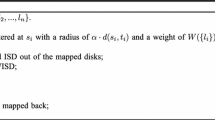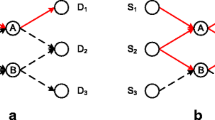Abstract
The capacity-achieving coding scheme for the multiple-input multiple-output (MIMO) broadcast channel is dirty-paper coding. With this type of transmission scheme the optimal number of active users that receive data and the optimal power allocation strategy are highly dependent on the structure of the channel matrix and on the total transmit power available. In the context of packet-data access with adaptive transmission where mobile users are equipped with a single receive antenna and the base station has multiple transmit antennas, we study the optimal number of active users and the optimal power allocation. In the particular case of two transmit antennas, we prove that the optimal number of active users can be a non-monotonic function of the total transmit power. Thus not only the number of users that should optimally be served simultaneously depends on the user channel vectors but also on the power available at the base station transmitter. The expected complexity of optimal scheduling algorithms is thus very high. Yet we then prove that at most as many users as the number of transmit antennas are allocated a large amount of power asymptotically in the high-power region in order to achieve the sum-capacity. Simulations confirm that constraining the number of active users to be no more than the number of transmit antennas incurs only a marginal loss in spectral efficiency. Based on these observations, we propose low-complexity scheduling algorithms with sub-optimal transmission schemes that can approach the sum-capacity of the MIMO broadcast channel by taking advantage of multiuser diversity. The suitability of known antenna selection algorithms is also demonstrated. We consider the cases of complete and partial channel knowledge at the transmitter. We provide simulation results to illustrate our conclusions.
Similar content being viewed by others
References
Foschini G.J., Gans M.J., (1998). “On Limits of Wireless Communications in a Fading Environment When Using Multiple Antennas”. Wireless Personal Communications, 6(3):311–335
Telatar I.E., (1999). “Capacity of Multi-Antenna Gaussian Channels”. European Transactions on Telecommunications, 10(6):585–595
Caire G., Shamai S., (2003) “On the Achievable Throughput of a Multiantenna Gaussian Broadcast Channel". IEEETransactions on Information Theory 49(7):1691–1706
Vishwanath S., Jindal N., Goldsmith A., (2003). “Duality, Achievable Rates, and Sum-rate Capacity of Gaussian MIMO Broadcast Channels". IEEE Transactions on Information Theory 49(10):2658–2668
P. Viswanath and D.N.C. Tse, “Sum Capacity of the Multiple Antenna Gaussian Broadcast Channel", in Proceedings ISIT 2002 Lausanne, Switzerland, p. 497, 2002.
W. Yu and J.M. Cioffi, “Sum Capacity of a Gaussian Vector Broadcast Channel", in ibid., p. 498.
Costa M., (1983). “Writing on Dirty Paper". IEEE Transactions on Information Theory 29(3):439–441
D.N.C. Tse, “Optimal Power Allocation Over Parallel Gaussian Broadcast Channels", in Proceeding ISIT 1997, Ulm, Germany, p. 27, 1997.
Cover T.M., Thomas J.A. (1991). Elements of Information Theory. New York, Wiley
A.G. Kogiantis, N. Joshi, and O. Sunay, “On Transmit Diversity and Scheduling in Wireless Packet Data", in Proceedings ICC 2000, Helsinki, Finland, pp. 2433 – 2437, 2001.
TIA/EIA/IS-856, cdma2000 High Speed Packet Data Air Interface Specification. Telecommunications Industry Association, Arlington, VA, November 2000.
TIA/EIA/IS-2000.2, Physical Layer Standard for cdma2000 Spread Spectrum Systems – Release C. Telecommunications Industry Association, Arlington, VA, May 2002.
R.W. Heath, M. Airy, and A.J. Paulraj, “Multiuser Diversity for MIMO Wireless Systems with Linear Receivers", in Proceedings Asilomar Conference on Signals, Systems, and Computers, Pacific Grove, CA, USA, pp. 1194–1199, 2001.
Viswanathan H., Venkatesan S., Huang H. (2003) “Downlink Capacity Evaluation of Cellular Networks with Known-Interference Cancellation". IEEE Journal of Selected Areas Communications, 21(5):802–811
D.J. Mazzarese and W.A. Krzymień, “High Throughput Downlink Cellular Packet Data Access with Multiple Antennas and Multiuser Diversity", in Proceedings IEEE VTC’03-Spring, Jeju, Korea, pp. 1079–1083, 2003.
O.S. Shin and K.B. Lee, “Packet Scheduling for MIMO Cellular Systems", in ibid., pp. 1694–1698.
D. Aktas and H. El Gamal, “Multiuser Scheduling for Multiple Antenna Systems", in Proceedings IEEE PACRIM’03, Victoria, Canada, pp. 502–505, 2003.
D.J. Mazzarese and W.A. Krzymień, “Throughput Maximization and Optimal Number of Active Users on the Two Transmit Antenna Downlink of a Cellular System", in ibid., pp. 498–501.
D.J. Mazzarese and W.A. Krzymień, “Design Rules for Efficient Scheduling of Packet Data on Multiple Antenna Downlink", in Proceedings 14th IST Mobile and Wireless Communications Summit, Dresden, Germany, June 2005.
Boyd S., Vandenberghe L. (2004). Convex Optimization. Cambridge, UK, Cambridge University Press
Horn R.A., Johnson C.R., (1985). Matrix Analysis. Cambridge, UK, Cambridge University Press
Gallager R.G. (1968). Information Theory and Reliable Communication. New York, Wiley
D.J. Mazzarese, High Throughput Downlink Wireless Packet Data Access with Multiple Antennas and Multi-User Diversity Ph.D. Thesis, University of Alberta, Edmonton, Canada, 2005.
S. Vishwanath, W. Rhee, N. Jindal, S. Jafar, and A. Goldsmith, “Sum Power Iterative Waterfilling for Gaussian Vector Broadcast Channels", in Proceedings IEEE ISIT’03, Yokohama, Japan, p. 467, 2003.
W. Yu, “Spatial Multiplex in Downlink Multiuser Multiple-Antenna Wireless Environments", in Proceedings IEEE Globecom’03, San Francisco, USA, pp. 1887–1891, 2003.
B. Hochwald and S. Vishwanath, “Space-Time Multiple Access: Linear Growth in the Sum-Rate", in Proceedings 40th Allerton Conference, Monticello, IL, USA, October 2002.
Zhang X., Kung S.-Y., (2003). “Capacity Analysis for Parallel and Sequential MIMO Equalizers". IEEE Transactions of Signal Processing 51(11):2989–3002
S.T. Chung, A. Lozano and H.C. Huang, “Approaching Eigenmode BLAST Channel Capacity Using V-BLAST with Rate and Power Feedback", in Proceedings IEEE VTC’01-Fall, Atlantic City, NJ, USA, pp. 915–919, 2001.
M.K. Varanasi and T. Guess, “Optimum Decision Feedback Multiuser Equalization with Successive Decoding Achieves the Total Capacity of the Gaussian Multiple-Access Channel", in Proceedings 1998 Asilomar Conference on Signals, Systems, and Computers, Pacific Grove, CA, USA, pp. 1405–1409, 1998.
Zheng L., Tse D.N.C., (2003). “Diversity and Multiplexing: A Fundamental Tradeoff in Multiple Antenna Channels". IEEE Transactions on Information Theory 49(3):1073–1096
Gorokhov A., Gore D., Paulraj A., (2003). “Receive Antenna Selection for MIMO Flat-Fading Channels: Theory and Algorithms". IEEE Transaction on Information Theory 49(10):2687–2697
Tu Z., Blum R., (August 2003). “Multiuser Diversity for a Dirty Paper Approach". IEEE Communications Letters 7(8):370–372
H. Yao and G.W. Wornell, “Lattice-Reduction-Aided Detectors for MIMO Communication Systems", in Proceedings IEEE Globecom’02, Taipei, Taiwan, pp. 424–428, 2002.
R.F.H. Fischer and C.A. Windpassinger, “Improved MIMO Precoding for Decentralized Receivers Resembling Concepts from LatticeReduction", in Proceedings IEEE Globecom’03, San Francisco, CA, USA, pp. 1852–1856, 2003.
Author information
Authors and Affiliations
Corresponding author
Rights and permissions
About this article
Cite this article
Mazzarese, D.J., Krzymień, W.A. Scheduling Algorithms and Throughput Maximization for the Downlink of Packet-Data Cellular Systems with Multiple Antennas at the Base Station. Wireless Pers Commun 43, 215–260 (2007). https://doi.org/10.1007/s11277-006-9219-2
Received:
Accepted:
Published:
Issue Date:
DOI: https://doi.org/10.1007/s11277-006-9219-2




